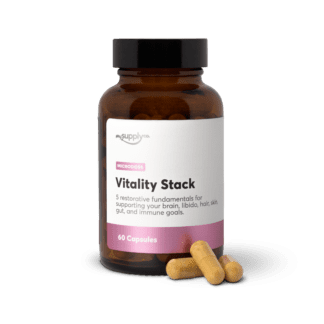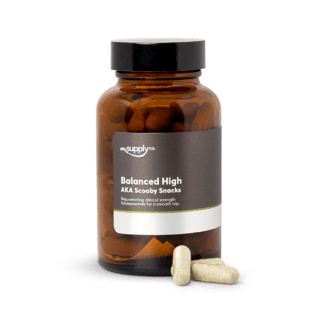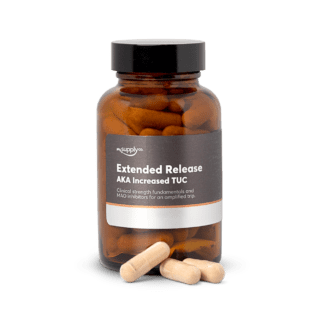Key takeaways.
-
What is neuroplasticity?
Neuroplasticity refers to the brain's ability to change and adapt to external stimuli over time. This includes neuronal death, neurogenesis (new neurons), creating new neuronal pathways and creating new synaptic connections.
-
Why is it beneficial to increase neuroplasticity?
Neuroplasticity is associated with learning, new experiences, and memory formation. The more efficiently the brain is able to create new neurons and new synaptic connections, the better we are able to perform these tasks. It can also benefit those with neurological disorders.
-
How do magic mushrooms improve your brain's neuroplasticity?
Magic mushrooms are thought to increase your brain's neuroplasticity via the 5HT1A serotonin receptor. In rodent studies, it has increased the rate of neurogenesis in the hippocampus and prefrontal cortex.
Up until recently, we believed the human brain stopped developing after childhood.
Today, we understand that our brains have an incredible propensity to adapt and change, even throughout adulthood. Our experiences — both joyful and traumatic — can cause the brain to both recognize and create new synaptic connections, a quality known as neuroplasticity.
And when we talk about neuroplasticity, we aren’t talking about an abstract psychological concept, but a tangible, measurable, and observable change in your brain's structural and functional connectivity.
Ongoing research into psychedelics like psilocybin magic mushrooms, MDMA, LSD, mescaline, ketamine, and more continue to reveal what Terrence McKenna was referring to in the Food of The Gods, the counterculture manifesto on mind-altering drugs and hallucinogens.
In it, the ethnobotanist posits that psychedelics change the way your brain works. And not in the negative way we were taught to believe they would, but in a positive and meaningful way that encourages continuing brain development and healthy aging.
That is if you do them in the correct set and setting.
To put it scientifically, there is continually emerging evidence that magic mushrooms improve your brain’s neuroplasticity.
In this article, we’re going to dive deeper into what neuroplasticity is, its importance for optimizing our health, longevity, and stress resilience, and some of the research behind psilocybin and its role in promoting neuroplasticity.
Let’s jump straight in.
What is neuroplasticity?

Neuroplasticity isn’t just a result of taking psilocybin or other substances.
Sometimes referred to as brain plasticity or neural plasticity, neuroplasticity describes your brain’s unique ability to create new synaptic connections and neural pathways.
It's when your brain is rewired to function in different ways, which it does by growing and reorganizing its neural networks in response to new experiences, learning new skills, and environmental stimuli. This phenomenon allows the brain to adapt to new circumstances, learn new information, form new memories, and recover from injury.
In addition to psychedelics and experience-dependent changes, neuroplasticity can be influenced by factors such as age, sleep, stress, and various forms of brain stimulation.
For example, studies have shown that certain forms of stimulation, such as repetitive transcranial magnetic stimulation (rTMS) or transcranial direct current stimulation (tDCS), can modulate activity in specific brain regions and potentially enhance certain cognitive functions.
And neuroplasticity occurs at multiple levels, from molecular changes in individual neurons to changes in large-scale networks involving multiple regions of the brain.
For example, when we learn a new skill, such as playing a musical instrument, new neural connections are formed and strengthened in response to repeated practice. This leads to an increase in the efficiency of communication between neurons, resulting in improved performance.
However, meaningful neuroplasticity relies on the availability of neurons in the brain, which brings us to neurogenesis.
The role of neurogenesis for neuroplasticity.
Neurogenesis is creation, and neuroplasticity is (re-)organization.
Neurogenesis is an essential part of neuroplasticity and a prerequisite for meaningful structural and functional changes in your brain.
You see, neurogenesis increases the pool of neurons available for rewiring and reorganization, or neuroplasticity.
It starts with the division of stem cells that, after turning into neurons, migrate to their final destination where they integrate into the existing neural network and establish new connections.
The impact of stress on neurogenesis.
Neurogenesis mainly occurs in the hippocampus and plays a crucial role in learning, memory, mood regulation, and stress response. For example, studies have shown that increased neurogenesis in the hippocampus is associated with improved learning and memory, while decreased neurogenesis has been linked to depression and other mood disorders.
In this way, neurogenesis plays an important role in the overall process of neuroplasticity by providing the brain with the building blocks necessary for adaptation and change.
How does this apply to you?
Neurogenesis in the hippocampus.
Well, prolonged exposure to stress is a given these days.
It's well-known in the scientific community that chronic or prolonged exposure to stress, whether physical, psychological, or social, can dramatically reduce your rate of neurogenesis. This subsequently leads to decreased cognitive function, which manifests as brain fog, poor memory and learning capacity, and fatigue, and increases your risk for mood and anxiety disorders.
So if you feel overly stressed or overwhelmed, if brain fog and fatigue are becoming the norm, you may want to consider introducing practices and supplements that stimulate neurogenesis.
Supplements include neurotrophic compounds like psilocybin, which we'll get into the next section, or lifestyle factors like experiencing novelty and enriched environments, getting good sleep and plenty of exposure to sunlight, aerobic exercise, and meditation.
This will in turn support neuroplasticity mechanisms, helping your brain become more adaptable and building your resilience to stress and disease.
Surprisingly, acute stress can actually improve your rate of neurogenesis, potentially enhancing certain forms of learning and memory—but only in the short term. It's your brain's way of helping you learn to adapt to acutely stressful situations, such as learning a new skill or overcoming a challenge at work.
The take-home message?
Understanding the underlying mechanisms and factors that contribute to neuroplasticity has important implications for a wide range of fields, including education, rehabilitation, and mental health.
Now, let's take a look at how psilocybin stimulates neurogenesis and neuroplasticity, and the impact it has on your cognition, behavior, and mood.
Psilocybin and brain plasticity (neuroplasticity).

Psilocybin has been studied to induce neurogenesis and neuroplasticity in two key brain regions:
- The prefrontal cortex (PFC), which plays a central role in executive function, or the ability to self-regulate and plan ahead. Examples of executive function include short-term memory, problem-solving, controlling your behavior and impulses, delaying instant gratification, regulating your emotions, planning, and making decisions
- The hippocampus, which plays a central role in learning and memory.
How psilocybin mushrooms stimulate neuroplasticity.
The changes psilocybin induces in the PFC and hippocampus are believed to result from the neurobiological pathways that psilocin activates. Psilocin is the primary psychoactive that psilocybin is converted into through our liver.
After psilocybin is converted into psilocin, it acts on a serotonergic receptor called “2A” (5-HT2AR).
This in turn activates specific pathways, or cascades of different proteins communicating and transferring a signal.
This chemical choreography, and its role, goes like this:
- Psilocin interacts with serotonin 5-HT2A receptors in the PFC. Psilocin, psilocybin's hallucinogenic metabolite, confers its mood-lifting and psychedelic effects by activating serotonin 5-HT2A receptors. These receptors play an important role in learning and cognition, as well as anxiety, depression, fatigue, and insomnia. Consistent studies also suggest that they exert powerful control over BDNF expression, and this may be a key mechanism underlying the therapeutic effects of psilocybin.
- This triggers glutamate signaling in the PFC. In human studies, PET imaging has shown that psilocybin increases glutamate signaling in the PFC. This is theorized to be important for psychedelic-enhanced plasticity since glutamate stimulates the production of brain-derived neurotrophic factors (BDNF).
- Which in turn stimulates BDNF expression. The activation of these two neurotransmitter systems subsequently leads to the release of brain-derived neurotrophic factor (BDNF), a direct indicator of neuroplasticity. Indeed, high levels of BDNF in the brain are associated with increased neuroplasticity, and low levels with mood and neurological disorders.
Psilocybin also influences neuroplasticity indirectly by interacting with plasticity-related genes and proteins.
Clinical studies on psilocybin and neuroplasticity.

In a 2018 study, researchers demonstrated the role of serotonin 5-HT2A receptors in neuroplasticity by giving participants a drug that kept psilocin from activating it. This stopped psilocin from binding with the receptors, along with its ability to promote neuroplasticity.
In a 2020 study, researchers demonstrated an increase in neuroplasticity mediated by higher glutamate levels in the PFC, but not the hippocampus, after psilocybin administration.
One study conducted on rodents at Johns Hopkins University showed that psilocybin at low doses was able to increase the number of newborn neurons in the hippocampus. The study was conducted around fear conditioning, and mice on the low dose were able to extinguish fear conditioning faster than the placebo and high-dose groups. However, it's generally thought that the 1A serotonin receptor mediates this, not 2A.
In another study, researchers showed that psilocybin rapidly increased gene expression related to neuroplasticity in the rodent brain. It was especially prevalent in the hippocampus and PFC.
As demonstrated in the illustration below, researchers in a 2020 human clinical trial found that structural and functional changes in the brain lasted at least 1 month after the participants' psilocybin journies, suggesting the presence of lasting neuroplastic changes.
During the trial, they discovered a staggering increase in resting-state functional connections across the brain from baseline to 1-week and 1-month post-psilocybin journey. The lines in red show new and strengthened connections, whereas the lines in blue show weakened connections.

Source: Barrett, Frederick S et al. “Emotions and brain function are altered up to one month after a single high dose of psilocybin.” Scientific reports vol. 10,1 2214. 10 Feb. 2020, doi:10.1038/s41598-020-59282-y
The left and right sides of each panel represent the left and right hemispheres of the brain, respectively. The inner ring corresponds to a node or region of interest within the brain, and the outer band of color indicates the lobe of the brain that each node resides in.
While it's too early to tell to what degree magic mushrooms will be applied in the context of neurological diseases, early evidence from clinical studies on psilocybin and other psychedelics demonstrate statistically significant improvements in patients with treatment-resistant anxiety, depression, PTSD, traumatic brain injury, cluster headaches, and postpartum depression. These improvements are primarily attributed to the sudden increase in neuroplasticity in the brain.
What does this mean for the everyday mushroom user?

It means that you might be replacing your conventional pharmaceuticals with psychedelics sometime in the near future. It also means that you could use it as a tool to facilitate flow, whether you're an entrepreneur, artist, musician, or mathematician.
Psychedelics induce changes in processes that persist beyond their initial administration, sometimes for up to 6 months. This suggests a biological adaptation, or neuroplasticity. Especially when you are intentional about your use, or couple it with a coach, therapist, or guide of some kind.
Some networks, such as those in the PFC regulating cognition, may remain plastic throughout life. Mediating this process and facilitating the rewiring of certain networks may be possible through the use of psychedelics.
The neuroplastic changes caused by a psychedelic trip are why you might feel inclined to learn new skills or become more creative after the experience. Or it might be why you're able to leave your house without crippling anxiety. Neuroplasticity is the outcome of learning and new experiences, and the profound psychedelic experience often lends itself to greater openness, creativity, expression, and idea formation.
Many psychonauts also express the ability to “see things differently” after a magic mushroom journey — which is another way of describing neuroplastic changes. For example, magic mushrooms can sometimes help us resolve a problem that seemed unresolvable before, whether it’s a math, romantic, or social problem. Could this be the result of creating new neuronal pathways or having greater synaptic connections?
We think so.
It’s really hard to say what neuroplasticity means in terms of measurable effects for someone who is completely healthy, stress-free, and doesn't have any goal or intention behind their use. But even stress and coping with stressors are affected by neuroplasticity.
What's your experience with psychedelics and neuroplasticity? Have you felt those improvements in mood, cognition, mindset, and overall adaptability to whatever came your way in the days and weeks that followed? We’d love to hear from you in the comments.
Psilocybin and neuroplasticity FAQs.
-
What is brain plasticity?
Neuroplasticity, often called brain plasticity, refers to your brain's remarkable ability to create new connections and pathways. It allows your brain to adapt, learn new skills, and reorganize neural networks in response to new experiences and environmental changes.
-
What influences neuroplasticity besides psychedelics?
Neuroplasticity is influenced by various factors, including age, quality of sleep, stress levels, and interventions like brain stimulation techniques such as transcranial magnetic or direct current stimulation. These elements play a role in how adaptable and flexible your brain can be.
-
How does neurogenesis relate to neuroplasticity?
Neurogenesis, the process of generating new neurons, is a fundamental component of neuroplasticity. It provides the necessary "building blocks" for the rewiring and reorganization of neural networks, thereby supporting the brain's adaptive capacity.
-
What's the impact of stress on neurogenesis and neuroplasticity?
Chronic stress can have detrimental effects on neurogenesis, reducing the creation of new neurons. This, in turn, leads to cognitive challenges such as brain fog, impaired memory, and learning difficulties. Furthermore, it increases the risk of developing mood disorders and anxiety.
-
Can psychedelics like psilocybin enhance neuroplasticity?
There is evidence to suggest that psychedelic therapy can promote neuroplastic changes in the brain. This increased neuroplasticity has the potential to benefit individuals struggling with mental health issues, as it allows for new insights, healing, and personal growth.
-
Does the strain of magic mushrooms affect neuroplasticity?
While different strains of magic mushrooms can influence the nature of the psychedelic experience, there isn't strong evidence to suggest that the strain directly impacts neuroplasticity. Neuroplasticity effects are generally associated with the psychoactive compounds themselves.
-
Can the potency of magic mushrooms affect neuroplasticity?
The potency of magic mushrooms may influence the intensity of the overall experience but doesn't necessarily correlate with increased neuroplasticity. The key factor in neuroplasticity enhancement is often the presence of specific psychoactive compounds like psilocybin.
-
Are there specific strains or potencies recommended for enhancing neuroplasticity?
Currently, there are no definitive recommendations for specific strains or potencies to enhance neuroplasticity. The potential for neuroplastic changes appears to be more associated with the presence of the active compound, such as psilocybin, rather than the mushroom's strain or potency. However, we would recommend the Golden Teacher magic mushroom strain from the Psilocybe cubensis species. Because it offers predictable dosages and a gentle and balanced journey, we use it in all our macrodose and microdose formulations, including our Balanced High macrodose capsules and Brain Stack microdose supplement.
-
How can I maximize neuroplasticity with magic mushrooms?
To enhance the potential for neuroplastic changes, it's essential to pay attention to your mindset, setting, and intentions when using magic mushrooms. Some individuals also find value in incorporating the expertise of a therapist, coach, or guide into their experience.
-
Are there long-term effects of using magic mushrooms for neuroplasticity?
Clinical studies suggest that the structural and functional changes in the brain following psilocybin use may have lasting effects. These changes can result in improved mood, enhanced cognitive function, and greater adaptability in response to life's challenges. However, the long-term effects of magic mushroom use are still an active area of research.
-
What conditions can benefit from neuroplasticity through psychedelic therapy?
Psychedelic therapy has shown promise in addressing various conditions, including treatment-resistant anxiety, depression, post-traumatic stress disorder (PTSD), traumatic brain injury, cluster headaches, and postpartum depression. Enhanced neuroplasticity is believed to contribute to these improvements.
-
Is psychedelic therapy a replacement for conventional treatments?
While psychedelic therapy shows significant potential, it is not yet a full replacement for conventional treatments. It offers an alternative approach for those who may not respond well to traditional therapies or are seeking a different path to healing.
-
How can I access psychedelic therapy for neuroplasticity enhancement?
You can access psychedelic therapy through one of the clinics listed in our Canadian directory of psychedelic therapists.
-
What changes might individuals expect in their daily lives after psychedelic therapy?
Individuals may experience improvements in mood, cognitive function, creativity, and adaptability after psychedelic therapy. Enhanced neuroplasticity is thought to contribute to these effects, enabling individuals to view and solve problems differently. However, the specific outcomes can vary among individuals.
Read: Microdose Cycling: What It Is, and Why You Should Be Doing It
Read: How to Make Magic Mushroom Gummies
Read: How to Make Magic Mushroom Brownies
Read: How to Lemon Tek Magic Mushrooms
Read: How to Make Shroom Tea: The Ultimate Mushroom Tea Guide




